Archive for Travel / lifestyle musings
April 28, 2008 at 10:07 pm · Filed under Travel / lifestyle musings
A big part of the enjoyment of the travel lifestyle has been having fewer things, but for us this trend is reversing lately. First we bought a house, then a second car to keep at the house, and now we have a third car.
To be sure, it’s not a glamorous set of wheels. It’s a slate gray 1983 Honda Accord, made back when Accords were smaller than today’s Civics, with a 75-hp engine and crank-up windows. Being a life-long Florida car, the paint is totally dead (closer to battleship gray on top, than the original slate color), but otherwise is in surprisingly good condition. It has just 60,000 miles on it.
Terry found it for us in Florida, and we bought it sight unseen a few months ago. He and Brett have been fixing it up for us with new plugs & wires, rotor & cap, hoses, belts, brakes and brake cylinders, valve cover gasket, fluids, filters, wiper blades, freon, and headlights. I picked it up today and put the new license plates on it. It runs perfectly, stops on a dime, and gets great mileage out of a gallon of gas. For a total investment of about $1,800 we have reliable transportation.
But what for? We bought this car because we anticipate spending summers in Vermont. A car to run around in is going to be helpful, so this car will be relocated there permanently.
The idea of having a third car, when we first thought of it, was frankly a bit annoying. We were doing so well at downsizing our possessions, and then suddenly we felt the need for another car. That’s why the “new” car is such a beater. Even with all the repairs and maintenance, our total investment is less than one-eighth the price of the 2007 Honda Fit we bought for our home base.
So it’s perfect for the job: no monthly payment, (hopefully) reliable, not worth insuring for more than liability, able to carry four people, and reasonably pleasant to drive. If it gets dinged in the parking lot we certainly won’t shed any tears for it. When it rusts, which it certainly will do after the first time it gets driven during a Christmas visit, we can accept the inevitable more comfortably than we could with a nicer car.
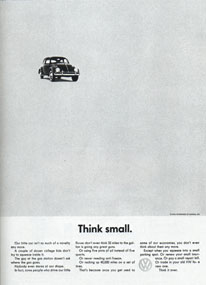 Mostly having it is a strategy to deal with the rising cost of fuel. Our cost per mile when towing has risen to about 41 cents lately, a record high since we started full-time traveling, and it will go even higher this summer. Driving the Nissan around without the trailer currently costs about 24 cents per mile, but with the Honda it is just eleven cents a mile.
Mostly having it is a strategy to deal with the rising cost of fuel. Our cost per mile when towing has risen to about 41 cents lately, a record high since we started full-time traveling, and it will go even higher this summer. Driving the Nissan around without the trailer currently costs about 24 cents per mile, but with the Honda it is just eleven cents a mile.
That really adds up over the course of several weeks, especially in Vermont where driving distances tend to be long. With all the driving we do there, shuttling Emma around to swim classes and visits with friends, driving the beater means a realistic savings of about $120 per week just in fuel, plus it keeps miles off the expensive Nissan Armada that we use to tow the Airstream.
That’s a very good thing, because everything about the Honda is economical, and most things about the Nissan are not. The Honda tires are tiny 13-inchers that cost about $30 each, versus $100 each for the Nissan’s tires. The wiper blades are smaller. The fuel tank is smaller. The oil changes are smaller. The insurance is smaller. And the payment is certainly smaller (zero).
Now that I think of it, maybe even though we’ve acquired yet another car, we might be making another move toward a “smaller” lifestyle. In some cases, I guess it’s not about the number of things you own, but how well you make use of them. We’ll see over the next few months if this little experiment pays off.
April 3, 2008 at 7:50 pm · Filed under Travel / lifestyle musings
We’re winding down this phase of our trip. This morning after breakfast, David & Ariadna hitched up and left. They’ve got a longer drive home, back to California. We’re expecting an email tonight from David, reporting on border crossing conditions and the proper detour through Hermosillo’s construction zone.
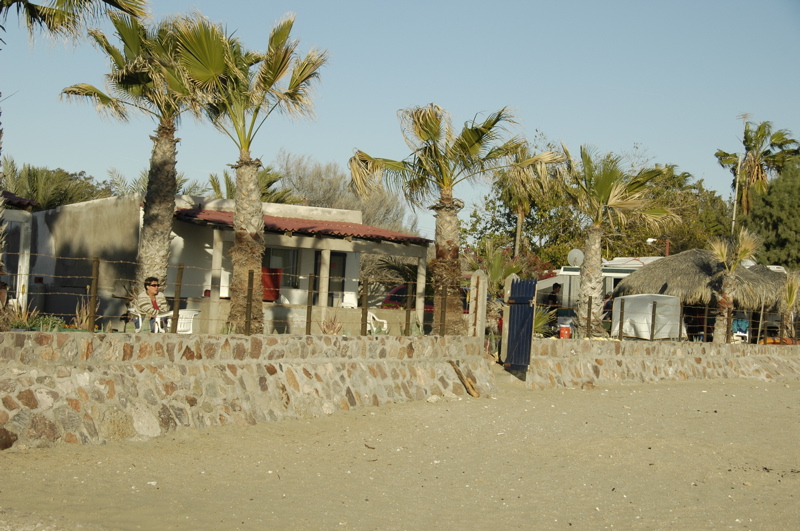
Their departure was the beginning of the dismantling our little temporary community. The wind came up in the afternoon and forced us to stow the awnings and chairs, and then Adam turned around the C so that he could dump the tanks, and suddenly the social hub of our Bahia Kino universe was gone. That is the way it always goes, and I’m used to it by now, but sometimes I feel the pang of loss when we tear down the set and move on.
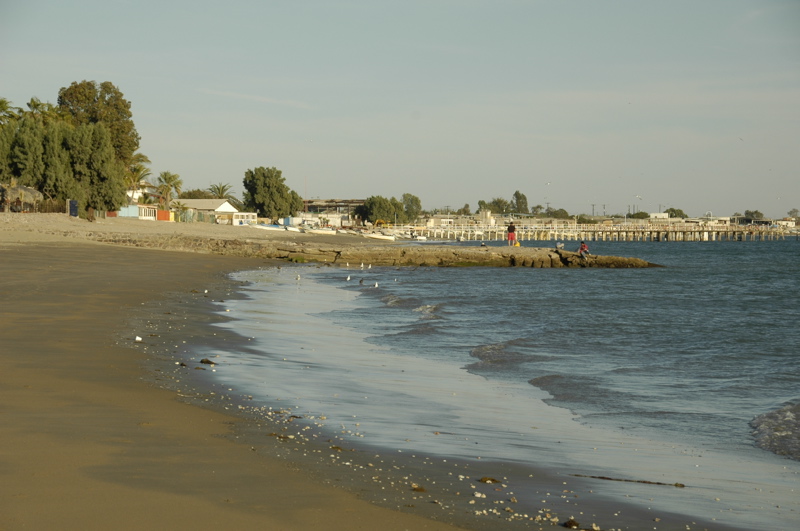
We filled the day with little things of no account, just because we could. Adam made egg breakfast for all, and we picked up two 5-gallon bottles of water to replenish our tank. We took a drive around some of the dirt back roads of Kino, and looked up a house that belongs to a friend of ours. The ladies collected some more shells, and Adam and I took a bike ride around town. It was the laziest time we have had in months.
We’ve had our share of local visitors today. This morning some young mothers and their children showed up with carved wood figurines made of ironwood. The Seri Indians of this area were well known for their ironwood carvings. I bought a simple owl carving for 20 pesos as a souvenir — a rare moment for me since I don’t usually collect souvenirs. In the mid-day we had our usual visit from the lady who collects aluminum cans, and in the afternoon a fisherman showed up with a kilo of fresh fish which Eleanor bought for 40 pesos.
Because we want to get an early start tomorrow, we paid for our campsite this afternoon. When we arrived the campground manager was happy to let us set up and stay without even a hint of interest in collecting our money up front, a huge departure from US practices. It was also refreshing not to be handed a four-page brochure full of rules and regulations. I gladly paid 720 pesos for our four-night stay and the privilege of being completely left alone by the management. I can recommend the Islandia RV Park in Bahia Kino (but be sure not to arrive during Spring Break).
By late afternoon it was feeling very much like siesta time, so I got a nap. (I’ve scored three in a row this week, a record.) Then a walk on the beach to see for one last time the pelicans and seagulls diving into the sea to catch fish, the jellyfish washed up on the sand, the local fishermen pulling in with their boats, and the sunset coloring it all.
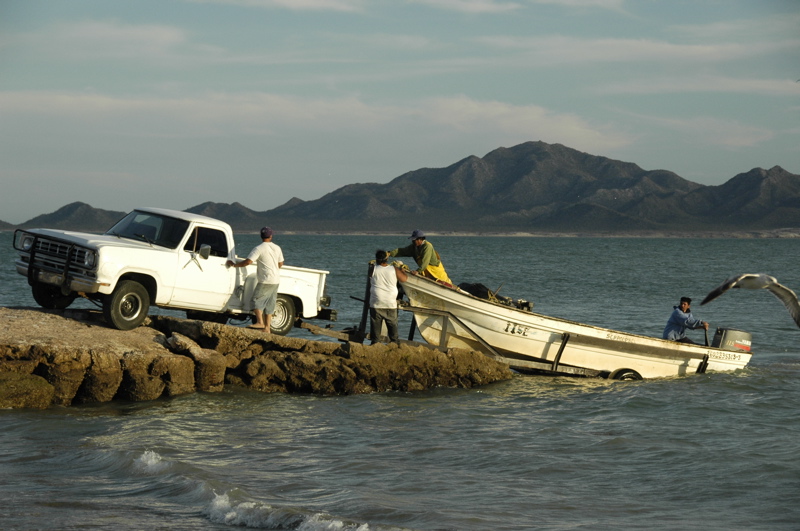
We may remember this trip to Mexico as the time we did absolutely nothing, but I for one will remember the laziness fondly. Soon we will be back to a frenetic pace of work and travel, much less indolent but perhaps more invigorating. We’ll also begin the eastward trek that will take about a month. Our goal is to dip our feet in the Atlantic ocean by mid-May.
March 16, 2008 at 7:06 pm · Filed under Home base, Travel / lifestyle musings
This morning we dropped off our houseguest, Christine, at a friend’s to go horse riding. All around Tucson there are pockets of “horse country,” where you can show up with your horse trailer and RV, park for a few months, and ride all winter long.

These places are basically spacious campgrounds in the country with horse boarding. The place we visited this morning is called Spirit Dog Ranch. It sits in a shallow valley near the base of the Santa Catalinas in Oro Valley, bordering Catalina State Park. We watched the horses playing for a few minutes, then headed out to do a little shopping.
Based on suggestions from blog readers, I bought a sacrificial anode rod for the water heater. As full-timers, it probably would have been a good idea to get one two years ago, but better late than never. The version I bought incorporates a quick-drain, useful for easy winterizing.
 Our travels will resume tomorrow, at least for a short time. We are heading to Sierra Vista for a few days, just to blow the cobwebs off the trailer. Officially, our purpose is to do some birdwatching and hiking, but in reality we’re just getting out of town to avoid sitting around another week waiting for the countertops to show up.
Our travels will resume tomorrow, at least for a short time. We are heading to Sierra Vista for a few days, just to blow the cobwebs off the trailer. Officially, our purpose is to do some birdwatching and hiking, but in reality we’re just getting out of town to avoid sitting around another week waiting for the countertops to show up.
Having been stopped since January, when I got back from Quartzsite, it’s interesting to experience the pre-trip excitement. I’ve been talking to Brent, who we are joining in Sierra Vista, every few days to “prepare” for the trip. There really isn’t that much preparation needed, but when you are looking forward to a trip, the preparation can be half the fun.
We have always anticipated each new phase of our trip, and every major stop, but of course there’s more contrast when you are parked and waiting to go. This trip is a mere 60 miles, less than we drove today to go shopping, but it has become a major event in our otherwise-sedentary lives. It’s not the distance that matters, it’s the change of scene.
Our other anticipated travel to Sonora, MX has attracted even more attention. Our friends the Neels have been emailed every few days with reports of their preparations. They are coming from California to meet us here, and then head across the border with us, around the 29th. Today’s email from David reported the status of his tires, wheel bearings, propane, insurance, family health, and iPod.
I also heard from Adam today. He and Susan are up in Maine, feverishly working to escape the damp, snowy, northeast and join us here for the Mexico trip as well. His reports are like David’s, and every few days I get an update on the progress.
I like getting the progress reports from my friends. It shows that they, too, are excited to travel. People who get excited about travel are the sort of people we like to travel with. There is no doubt we will have a superb time because of our friends, and that’s the best type of trip to be anticipating.
March 14, 2008 at 11:52 am · Filed under Travel / lifestyle musings
I cannot imagine a more frustrating subject than that of health care for full-time travelers. How do you make sure you are covered, if a problem crops up while you are on the road? It is one of those questions that has no good answer.
I have spoken to dozens of people about this, and numerous full-timers, and it is clear there is no “magic bullet” solution. Most of my retired traveling friends have government- or corporate-sponsored retirement health plans, so they don’t worry about it. Others are carrying over their health insurance from their last jobs, under the COBRA act. Some are covered under a spouse’s plan. But quite a few are “bare” — meaning they have no insurance at all, or inadequate insurance.
We fall in the last category: our coverage is really inadequate. For everything except emergencies, we have to go back to Vermont. When Eleanor had a major migraine episode two years ago, we paid cash for medical care in Tampa, then flew her to Vermont for follow-up. Obviously that’s far from ideal.
For those who do have health insurance, when I ask what happens if they get sick while far from home, most don’t know. They aren’t sure if their health insurance covers them out-of-state, and if so, for how long. Emergencies only? Follow-up visits? Full reimbursement, or just partial? When I ask, I usually get a blank look.
Most people aren’t sure if they are covered in while traveling in Canada or Mexico. They don’t know if they will have to pay up-front and fight for reimbursement later. They don’t know how to get a doctor referral in a strange town.
And even if you know all those answers … can you afford health insurance without an employer to pay most of the premium?
I hate to dry up the blog with a subject like this, but it’s a huge problem — for us, and for many others. We are at the intersection of two negative factors: we are full-time travelers, and I am self-employed. That means we need coverage that goes everywhere in the USA, and we need something that is affordable. But in the US, you can have a nationwide network of doctors, affordable prices, or good reimbursement for your expenses — pick any two.
The current presidential campaign certainly has brought up the issue of health care cost and availability, but I am not filled with hope that any of the candidates will be effective at doing something about it. The problem is huge. It seems likely that for the foreseeable future I’ll be responsible for paying for the health care of my family.
On the plus side, we have small advantages. We can become residents of a state where there are more healthcare insurance options. As my own employer, I can institute any health plan that is available to us. A lot of people are going to partially self-insured plans, or “consumer directed coverage” such as a Health Savings Account (HSA). That may be an option for us.
But in the current health care environment, any solution is complex, filled with little “gotchas” and highly individualized. What works for us may not work for you. So when people innocently ask me, “What do you do about health care on the road?” I can only sigh … because I know any answer I give will probably not be useful.
Status report: Little things are happening, but still not much. Jim Breitinger (“the Airstreaming Meteorite Dealer“) is in town, and he dropped by for lunch on Wednesday. Contractor Chris has been here to work on the shower tile both Thursday and Friday, but with grout drying time and sealant, the shower won’t be available to us until next week. Still no word from the countertop guys, and we don’t expect to hear anything for a week.
We gave the grapefruit tree a major trimming yesterday. The poor thing has been badly neglected and allowed to grow in all sorts of crazy directions. I’m trying to convert it from a fluffy green bush to a real tree that can produce more than a dozen grapefruit. Now it looks like a kid with a new military haircut. That’s the first step toward improving the backyard. Up to now it has been just a dumping ground for the contractors. It’s basically made up of weeds, cut-off bits of tile & slate, and junk. Rather than try to fix it up, we’re going to leave it looking like a back alley this summer. It’s a project for another day.But I will at least make sure the old toilet, junk plywood, scum-encrusted shower doors, and garbage cans are cleaned up before we go.
I’m thinking about stuff like that because our departure is looming in a serious way now. Time to start on the checklist of items: set up house-watching, clean up the junk, clear out the refrigerator and freezer, re-pack the Airstream, pump up the tires and lube the hitch, etc. The list is not long and that’s a good thing, because we bought this house with the intent of having it be easy to live in, and easy to leave.
March 8, 2008 at 11:07 pm · Filed under Travel / lifestyle musings
Tonight I am letting Wally Byam take over the blog. My friend Dale Schwamborn, who I introduced in this blog a few days back, has shared with me a letter written by Wally to one of his fraternity brothers (Wally was a Sigma Chi). See if you can see the similarities in travel perspectives (to mine, and your own) in Wally’s letter from half a century ago:
———————-
April 20, 1959
Dear Sam:
Nice to get your note … I’m asking the secretary of the Wally Byam Caravan Club to send you a copy of ‘Parade’ magazine. They wrote a rather interesting article about me, and also, did you know that National Geographic Magazine devoted 35 pages to the Wally Byam Caravan to Europe in their June 1957 issue? More recently, I’ve appeared on coast to coast television programs with my caravan to Central America.
Right now we are preparing a caravan of some 40 trailers and trucks, which will sail for Africa in May and June of this year and leave Capetown in South Africa on July 14th, on a 12,000 mile trip north through Africa, eventually coming out in Cairo on December 5th. In the process, we expect to park the caravan under the nose of the sphinx in the Nile valley and if luck goes with us to be in Bethlehem on Christmas Eve. All these things make startling and interesting publicity. The real interesting thing is that although this trip to Africa has never been done before by a group of caravanners such as ours and has a lot of elements of real adventure and not small element of danger in it, the average age of the people going is 67 years and the oldest man is 87. They all drive their own trucks and act in a general way like kids. The trick is that with trailers like ours they can rest whenever they get tired and they have all the comforts of home, including hot and cold running water, showers, bathtub, flushing toilet, wonderful beds, refrigerators, good stoves, air conditioners, just about everything you could call for. Thus, the old guy really takes life easy on a very hazardous journey. I wonder if any of these things would make a good story for some of the Sig magazines sometime. You can’t blame a guy for tooting his own horn occasionally.
Apparently the only people still living from my class at Stanford are Eddie Randall, who I often meet in Washington D.C. and Tex Talbert of Beverly Hills. Tex says he doesn’t go to meetings anymore because he is always the oldest guy there and he does not like that designation.
I sure hope I can drop in some noon, but it seems that I am always traveling.
Very sincerely,

Wally Byam
————————-
If you know anything about Airstream’s history, you know that the Cape Town to Cairo caravan became the most famous caravan in Airstream’s history, and probably the most publicized caravan in all of RV’ing history. Wally knew he was on to something — and as you can see, he was a relentless publicist — but I bet even he didn’t know how important this trip would be. We still talk about it today, and publish the photos in Airstream Life magazine.
I find his closing line to be the most poignant of this letter. He was indeed always traveling, and apparently enjoyed that more than anything else in life. Three years after this letter was written he died of cancer, at a relatively young age by today’s standards, but with an incredible and fulfilling life behind him.
March 6, 2008 at 12:20 am · Filed under Travel / lifestyle musings
With a lot of time spent parked lately, and the prospect of three more weeks, we’ve had time to get new perspective on our travels. I know when we were heading here last December that I said it would be good to stop a while, but it’s getting ridiculous. We’ve been here for about eight weeks and it feels like longer.
Hey Universe! I’ve got perspective, really — can I go now?
I think we’ve crossed this country coast-to-coast about seven times in our Airstream. Every time we start another continental drive I always think, “This might be our last trip. Better make it a good one,” because we never truly know if we’ll get another chance. Even the first trip across (east to west), we thought we’d be at this for just six months and so we tried to see as much as we could before “the trip” ended.
The same is true today. We know we’ll go east and come back west, but beyond that my crystal ball is cloudy. So many things can happen that might sideline us for a long period of time. So as we head east I’m searching for new things to explore. We’ve never checked out Arkansas, and we’ve hardly spent any time in Tennessee. We’ve never been to North Dakota, hardly any of Minnesota, and there’s a lot of Idaho and eastern Washington I’d like to visit.
But we also want to visit friends and revisit some great spots. So I’m conflicted. If we stick to familiar places we might miss something (or someone) new and great. Somehow we’ve got to find a balance between the familiar and the novel. I stare at the road atlas again and again, waiting for the perfect route to pop up and announce itself.
People are asking if we’ll curtail our travels due to rising fuel prices. No, because really fuel is not a terribly expensive component of our travel. The trip to New England, via Florida, and back, will probably cost about $2,500-3,000 in fuel. Sounds like a lot, but keep in mind what we get for that:
- we can take our home with us, so no hotel rooms, no using the “spare bedroom”, and complete comfort at all times
- all the convenience that having everything with us entails, including Eleanor’s kitchen and my office
- unlimited nights on the road with very little added expense (most of the time we’ll be either courtesy parked or getting the monthly rate at a campground)
- incredible flexibility in scheduling; freedom to make changes of route or length of stay at any time without penalty
- much lower cost in food, because we can eat in our own kitchen instead of eating out.
What’s our alternative? Three airfares back to Vermont would cost about $900 and we’d be living out of suitcases, renting a car, and forced to a rigid, short schedule. No stops in Texas, Louisiana, Florida, or the Outer Banks either. No chance to visit friends all over the country. Bah. I’ll take the six-month tour in the Airstream instead, even at three times the cost. On a per-day basis, it’s still the cheapest traveling we’ll ever do.
But hey, maybe next year gas will be $15 a gallon. Maybe we’ll have some health problem that restricts our travel for a while. Who knows? We’ll have to take this trip like it really is our last, just in case.
So I’m planning. And re-planning. It has been a huge challenge to figure out a route, and I’m not done yet. The moving target deadline for the house hasn’t helped. Because of our later departure we may cut our planned service stop short, too, just getting the necessary stuff done and then moving on. Even as full-timers*, there’s never enough time to see and do all the things you want. This is a big country with over 300 million people in it, and 49 states you can drive to. I can’t imagine ever getting bored with exploring it, or with planning the next trip.
* We have been sleeping and cooking in the Airstream for the past eight weeks, so even though we are not moving, we’re still full-timers! (So there, Gadget!)
February 29, 2008 at 11:20 pm · Filed under Travel / lifestyle musings
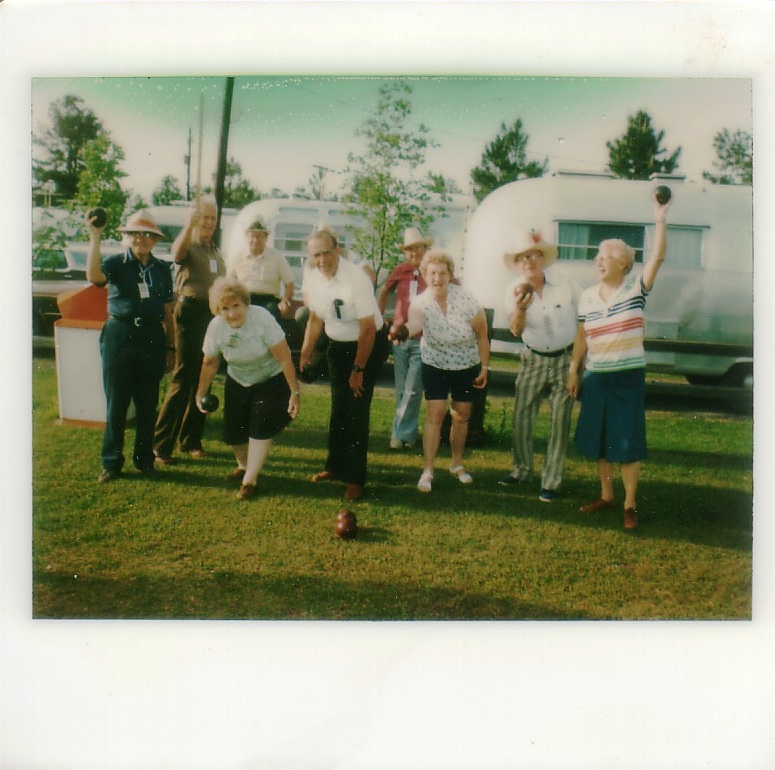 From time to time I am lucky enough to receive some family photos from a friend or Airstream Life subscriber, showing their parents and grandparents (and sometimes great-grandparents) having fun with their Airstream. I always treasure these, and sometimes we run them in the magazine.
From time to time I am lucky enough to receive some family photos from a friend or Airstream Life subscriber, showing their parents and grandparents (and sometimes great-grandparents) having fun with their Airstream. I always treasure these, and sometimes we run them in the magazine.
The pictures are often blurry, out of focus, or the colors have faded over the decades. The slides have scratches and the handwriting on the prints is illegible, but all that seems to only increase the quaintness of the photos, which seem to capture a very simple and fun time.
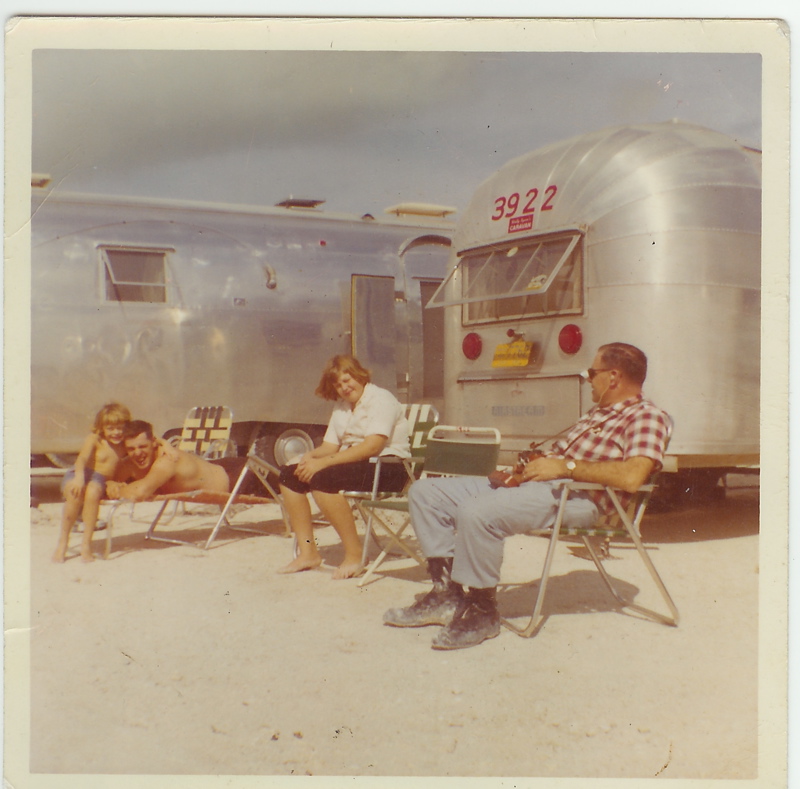 Of course, that’s an illusion, since when the photos were taken people had things to worry about too. Instead of a mortgage crisis and war in Iraq, they might have been taking a break from the Cuban Missile Crisis or the Vietnam War. Not much has changed when you look at it that way, and even the Airstreams look pretty much the same at first glance.
Of course, that’s an illusion, since when the photos were taken people had things to worry about too. Instead of a mortgage crisis and war in Iraq, they might have been taking a break from the Cuban Missile Crisis or the Vietnam War. Not much has changed when you look at it that way, and even the Airstreams look pretty much the same at first glance.
But in the images all seems to be well. People are enjoying the good things in life: family, friends, a sunny day, a moment away from the care of everyday life. They don’t need much in these photos to appear to be having a good time. No satellite TV here, nor major theme parks. The novelty of buying a pineapple or having a friendly chat over a haircut can be the center of a good time in vintage photo-land.
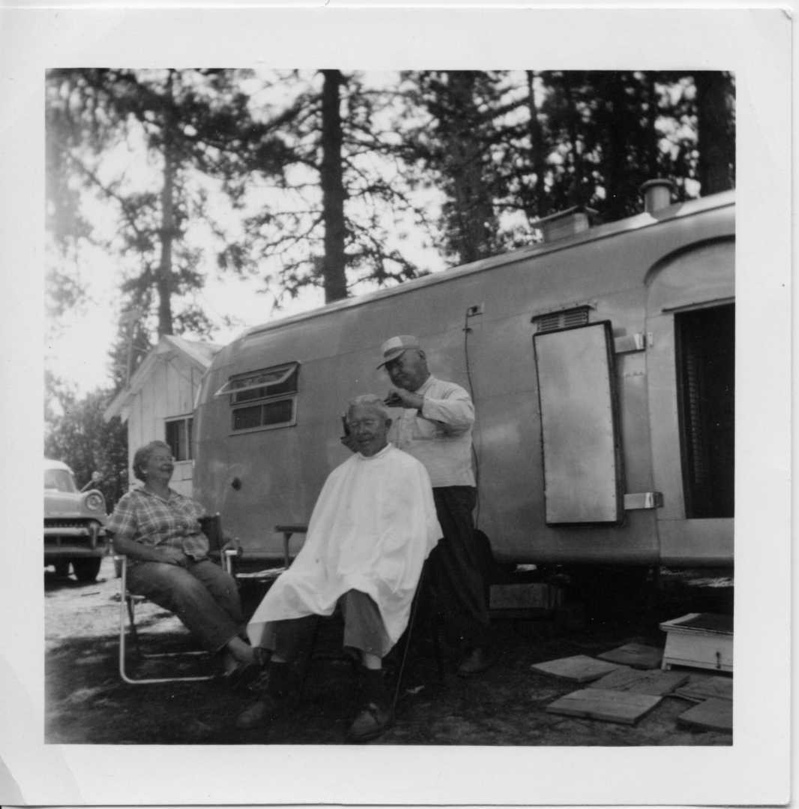 These photos seem very precious now, since snapshots were less common then than now, and since so many of them have not survived. Certainly tens of thousands more are stored in attics all over the world, and once in a while they pop up on eBay. Two years ago a large collection of Ektachrome slides came up from an estate sale, and since (judging by the slide description) the photographer was an Airstream owner who had gone to Mexico on a caravan, I bought them. I was hoping that out of several hundred slides I might find a dozen or so worth keeping. In the end, only about five were really of interest, and even those were marginal. It’s a gamble trying to buy old slide collections, but I keep looking.
These photos seem very precious now, since snapshots were less common then than now, and since so many of them have not survived. Certainly tens of thousands more are stored in attics all over the world, and once in a while they pop up on eBay. Two years ago a large collection of Ektachrome slides came up from an estate sale, and since (judging by the slide description) the photographer was an Airstream owner who had gone to Mexico on a caravan, I bought them. I was hoping that out of several hundred slides I might find a dozen or so worth keeping. In the end, only about five were really of interest, and even those were marginal. It’s a gamble trying to buy old slide collections, but I keep looking.
The best collections come from second and third-generation Airstream owners. They know the historic value of their grandparent’s photographs, and when they offer a set to me (usually in the form of scans, which is fine), it’s always a great collection of candids that portray Airstream travel as it really was. 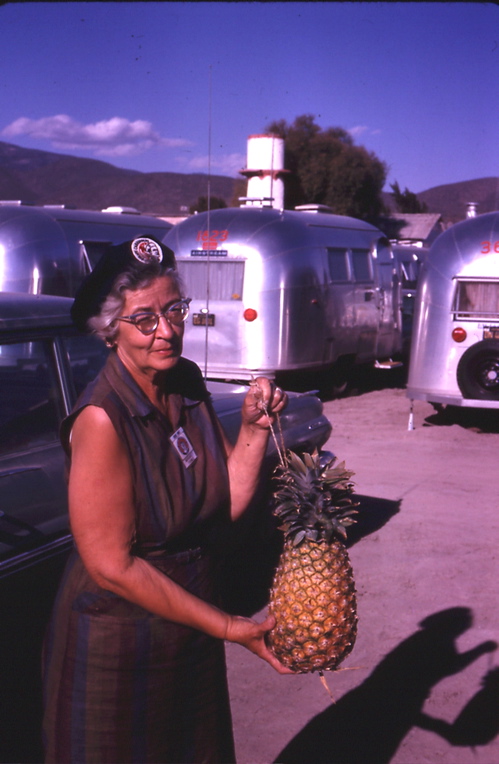 In addition to the usual beauty shots of gorgeous landscapes and overviews of rallies, people chatting and people playing, I will see images of people doing mundane daily tasks like eating dinner, or digging a hole for the sewage. There’s an aspect of honesty in these collections that I can’t get from official publicity shots, even though the staged images are usually more photogenic.
In addition to the usual beauty shots of gorgeous landscapes and overviews of rallies, people chatting and people playing, I will see images of people doing mundane daily tasks like eating dinner, or digging a hole for the sewage. There’s an aspect of honesty in these collections that I can’t get from official publicity shots, even though the staged images are usually more photogenic.
I mention all this for two reasons. First, I’d like to encourage people to send their vintage family photos to me for the Airstream Life collection. I’d like to run more in the magazine, but finding good images is a challenge and I need your help.
Second, keep in mind that a lot of the snapshots you take today will be invaluable to your family decades in the future — even some of the more boring ones. Your kids will look through the shots of themselves camping and remember mostly the good times. You will always look at yourself in the photos and think “How young I was then!” And perhaps someday something that seemed commonplace when you took the photo will be extinct or nostalgic, and the photo you took will be a record of it. Even thumbing through the images we took as recently as 2003 (when we bought our first Airstream), all three of the above things have happened to us.
Your Airstream is a time machine. It connects you to the 70+ years of Airstream history and your own family’s history. It may be a bit different from the ones of the 1950s or 1960s, with a flat-screen TV and a satellite radio, but the aluminum body and carefree lifestyle it enables remains exactly the same. Next time you’re out in the Airstream, think about the history you’re making for your family or yourself.
Photo credits FIRST: (Unknown). SECOND: Marathon FL, 1962. Courtesy Rob Baker, THIRD: Bert Richter gets a haircut from F. Brick during the 1958 Western Canada caravan. Courtesy Herb Richter. FOURTH: Mrs. LaVergne and her pineapple. Courtesy her grandson Thomas LaVergne.
« Previous entries ·
Next entries »
 Mostly having it is a strategy to deal with the rising cost of fuel. Our cost per mile when towing has risen to about 41 cents lately, a record high since we started full-time traveling, and it will go even higher this summer. Driving the Nissan around without the trailer currently costs about 24 cents per mile, but with the Honda it is just eleven cents a mile.
Mostly having it is a strategy to deal with the rising cost of fuel. Our cost per mile when towing has risen to about 41 cents lately, a record high since we started full-time traveling, and it will go even higher this summer. Driving the Nissan around without the trailer currently costs about 24 cents per mile, but with the Honda it is just eleven cents a mile.










